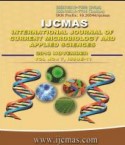


 National Academy of Agricultural Sciences (NAAS)
National Academy of Agricultural Sciences (NAAS)

|
PRINT ISSN : 2319-7692
Online ISSN : 2319-7706 Issues : 12 per year Publisher : Excellent Publishers Email : editorijcmas@gmail.com / submit@ijcmas.com Editor-in-chief: Dr.M.Prakash Index Copernicus ICV 2018: 95.39 NAAS RATING 2020: 5.38 |
A field study was conducted to screen out six important tomato genotypes for resistance/ tolerance against important sucking pests and their natural enemies under West Bengal conditions. Aphid (Aphis gossypii Glover) and whitefly (Bemisia tabaci Genn.) were first appeared on the crop in third week of January and second week of February respectively. The peak populations of both the pest were reached in the third to fourth week of February. The maximum (r= -0.027 and -0.210) and minimum temperatures (r= -0.138 and -0.283) and minimum relative humidity (r= -0.191 and -0.031) were found to exert unfavorable influence on population development of whitefly and aphid species and showed negative correlation whereas maximum relative humidity (r=0.225 and 0.428) and sunshine hour (r=0.547 and 0.387) favoured the population build up. Results showed that none of tested tomato genotypes were found either as tolerant or resistant against aphid and whitefly. In terms of relative susceptibility against aphid and whitefly, the tomato genotypes could be arranged in the following sequence (higher to lower): NS 501>Priya>Roja> Romeo>Rubi>Patherkuchi and NS 501> Romeo>Rubi>Priya>Roja>Patherkuchi respectively. Here Patherkuchi was found less susceptible for both the pest aphid (16.05/leaf) and whitefly (0.20/leaf) as well as found to be immune (0.00 %) against ToLCV disease incidence. Remaining other genotypes were moderately susceptible (Ruby, Roja cherry, Romeo and Priya) to highly susceptible NS501 (20.77/leaf and 0.40/leaf).
 |
 |
 |
 |
 |